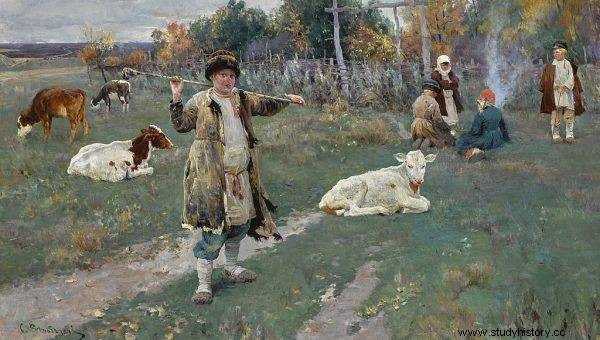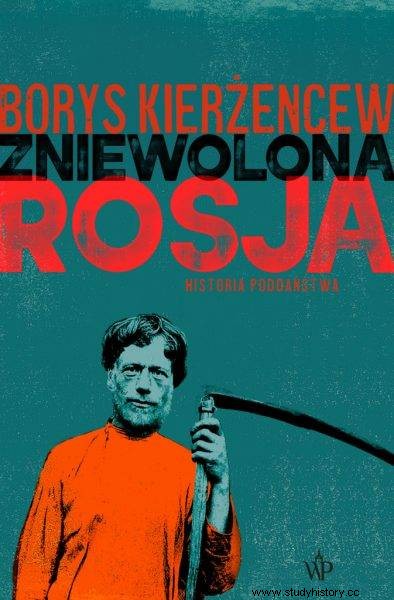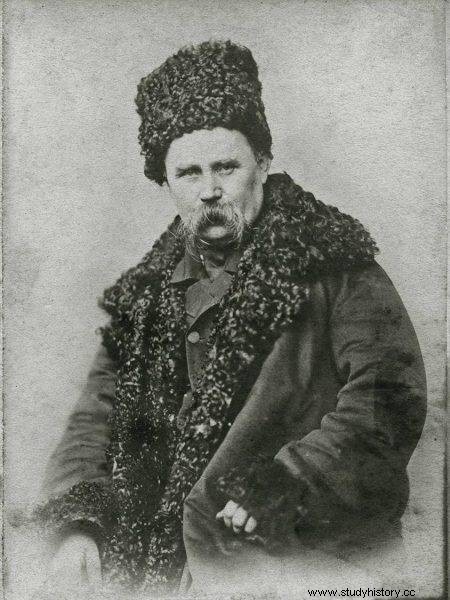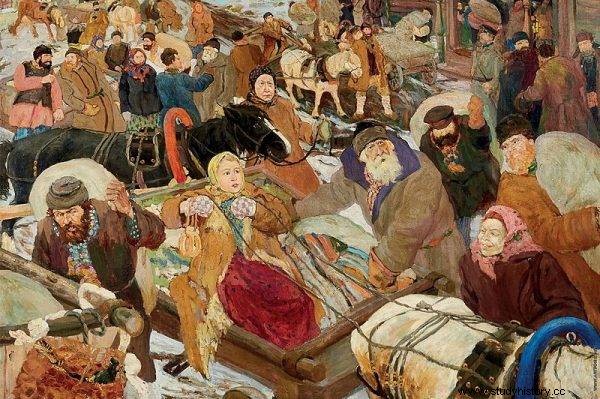In tsarist Russia, peasants were the property of the lords who could dispose of their lives as they saw fit. After all, the peasant was "just a commodity".
The submission of the Russian peasants at its worst began to take shape at the end of the 16th century. Until 1497, they had the right to change the owner after fulfilling the formalities provided for by law.
The transition to the jurisdiction of another gentleman was possible during the period of "Jurjewo day", that is, the day of St. George - from November 19 to December 3.
In 1581 (or 1584) Tsar Ivan the Terrible canceled this rule. How disappointed the peasants were is evidenced by the fact that even wrote the proverb "Wot tiebie babuszka Jurjew dień" (the Polish equivalent is:"You have a babo cake") . This phrase is still used today.
What to do with unnecessary service
The following decades resulted in more and more enslavement of the subjects. For example, in 1597 the search period for an escaped peasant was 5 years, in 1644 - 15 years , and in 1649 Tsar Alexius decided that the escape of a serf peasant would not be time-barred.
As Borys Kierżencew writes in the book Captive Russia. The history of serfdom , his son - monarch reformer Peter I - led to:
the final formation of a utilitarian view of serfs as sacred property that can be donated, pawned, sold on the market in bulk and in retail.

In 1649, Tsar Alexius decided that the escape of a serf peasant would not be time-barred.
In 1747, his daughter Elizabeth issued landowners permission "to sell their peasants and servants in order to make them recruits in place of merchants and other landowners who had a duty to serve in the military." This is how the Russian serfdom was objectified.
Read also:The life of a serf
Marriage for Sale
In the book "Captive Russia" you can find many examples of transactions in which people were bought and sold. Peasants were bought, for example, at public fairs.
An old court servant mentioned that his mistress chose "boys and girls, thirty men together", who were then taken to the market square in the city of Uriupinsk. "There was [then] crying in the countryside when you started to go to Uriupinsk," noted the servant.

The text was created, among others based on the book by Boris Kierżeniew "Captive Russia. A History of Subjection ", which has just been released by Wydawnictwo Poznańskie.
If any landowner did not want or could not go to the market, he could read advertisements about the possibility of acquiring servants in the Russian press. Moskowskije Vedomosti has published the following announcement:
Unnecessary court service is sold:shoemaker 22 years old, his wife - laundress (...). underwear (...). You can see them in Ostożena at number 309.
Kierżencew points out that the same announcement contained information on the sale of “six young bay dogs of light breed, well-harnessed.” The price of the bay was 1200 rubles, and the value of a married couple was 400-500 rubles.
Read also:The revolt of Polish peasants against ... Polish lords. What was the Galician plunder?
Taras Shevchenko - a peasant who was lucky in his life
As the peasants were only a commodity and a way to make a profit, the owners did not care about their mental state. Often husbands were separated from wives, children - with parents, brothers - with sisters. They were used at every opportunity, a great example of which is Taras Shevchenko
This outstanding Ukrainian poet, painter and ethnographer, who lived in the years 1814–1861, was also born as a serf, property of Vasily Engelgardt. At the age of 11, the boy became an orphan. He was a shepherd in his master's estate.

Taras Shevchenko, an outstanding Ukrainian poet, painter and ethnographer, who lived from 1814 to 1861, was also born a serf.
Already then he began to show his painting talent, but Engelgardt - when he saw his servant drawing - ordered to beat him . Over time, you came to the conclusion that Taras and his art are the source of his income.
In 1831 Engelhardt moved to St. Petersburg, taking Taras with him. There he sent the boy to study at the painter Vasily Shirayev. He hoped that when Shevchenko perfected his painting technique, he would make good money on it.
During his studies, Taras secretly sneaked out at night to one of the most beautiful gardens in the Russian capital - the Summer Garden. He drew sculptures located there. It was then that fate put his compatriot, painter Ivan Soshenko on his way, thanks to whom the most outstanding artists learned about the sad life of a talented boy of the era:painters Karol Briułłów and Alexei Wenecjanow and the poet Vasily Żukowski.
The price of human life
New friends decided to buy Shevchenko so that he could study at the Academy of Fine Arts in St. Petersburg. Engelhardt agreed to give his peasant freedom for an exorbitant amount of 2,500 rubles - the equivalent of 45 kilograms of pure silver!
Artists who did not have such an amount found a solution:Karol Bryullov was to paint a portrait of Vasily Zhukovsky, then the painting was to be auctioned, and the money obtained was to be given to Engelhartdt.
The family members of Nicholas I found out about Taras's situation - his wife, Alexander Fedorovna, paid 400 rubles, and the heir to the throne, Alexander, and his sister Maria - 600. On May 4, 1838, Żukowski's portrait was bought. Having received a document certifying his release from servitude, Shevchenko began to cry and repeated:"Freedom, freedom, freedom!".
Taras began his studies at the Academy of Fine Arts in St. Petersburg, although he gained the greatest recognition not as a painter, but as a poet.
Read also:Were our great-grandparents slaves? What was the life of serfs really like?
Abolition of subjection
The question arises: were the rulers of Russia aware of the criminal nature of serfdom? Definitely yes, but the landlords and nobility were so used to having cheap labor and humble service that the monarchs could not dare deal with this shameful situation for a long time.

Alexander I, grandson of Catherine the Great, banned the publication of advertisements about the sale of people in the press. But the nobility found a way around this provision.
For example, Catherine II in a confidential conversation with one of her trusted courtiers said that the nobility would "lynch" her for even partially abolishing serfdom.
Her descendants were also aware of what serfdom really was. In 1801 Alexander I, grandson of Catherine the Great, forbade the publication of advertisements for the sale of people in the press. But the nobility found a way to circumvent this provision and began posting advertisements about the "hiring" of serfs , which was a "disguised offer to sell."
In turn, Nicholas I forbade the separation of peasants' families, but also this time the monarch's decree was not respected. This is because - as we read in the book "Enslaved Russia" - "the abuses that became the norm were so used to that they were treated as the right thing"
It was only Alexander II who abolished the serfdom - it happened on February 19, 1861.
Sources:
- Kierżencew B., Captive Russia, 2021.
- КРЕПОСТНОЕ ПРАВО (КРЕПОСТНИЧЕСТВО), https://w.histrf.ru/ (accessed:10/11/2021).
- The website of the T. Shevchenko Museum, https://museumshevchenko.org.ua/ (accessed:October 11, 2021).
